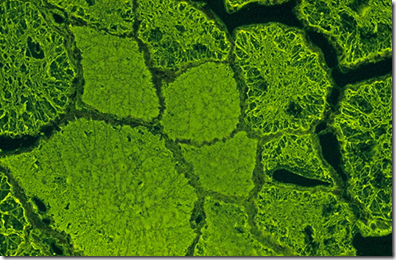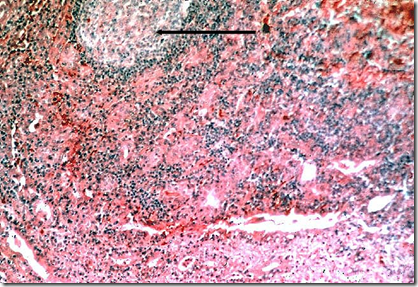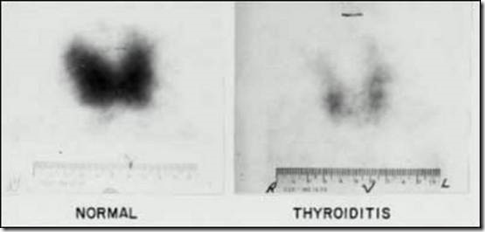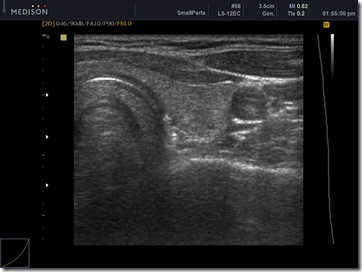Hyperthyroidism
Clinical features:
- Increased BMR
- Heat intolerance
- Weight loss
- Increased appetite
- Peripheral vasodilation
- increase heat loss
- increase blood flow
- skin soft, warm & flushed
- Increase cardiac output
- tachycardia
- palpitations, arrhythmias
- cardiomegaly
- congestive cardiac failure
- cardiomyopathy
- Overactivity of sympathetic nervous system
- tremor
- hyperactive
- anxiety
- inability to concentrate
- insomnia
- proximal muscle weakness due to muscle mass loss
- Ocular changes
- staring gaze
- lid lag
- sympathetic nervous system overstimulation of levator palpebrae superiosis
- Hyperstimulation of gut
- hypermotility
- malabsorption
- diarrheoa
- Bone resorption
- osteoporosis
- risk of fracturss
- Hepatomegaly
- fatty deposits in liver
- Hair loss
- Oligomenorrhea
- Thyroid storm (abrupt onset of severe thyrotoxicosis)
- Febrile
- Increase heart rate (in response to fever)
- Emergency (death from cardiac arrhythmias
Apathetic hyperthyroidism
- seen in elderly
- age & other co-morbidities blunt effects of excess thyroid hormone
- effects not clearly seen eventhough hyperthyroid
- diagnosed when seen for unexplained weight loss/ worsening cardiovascular disease
Cause/aetiology
Primary
- Thyrotoxicosis (High T3,T4)
- most common
- Diffuse hyperplasia
- Grave’s disease (85%)
- Hyperfunctional multinodular goiter
- Multifunctional adenoma of the thyroid
- Other:
- Subacute granulomatous thyroiditis
- Subacute lymphocytic thyroiditis
- Struma ovarii
Secondary
- TSH-secreting pituitary adenoma
Epidemiology
- 2% of female population
- More female than male
- 30-40 years old
- Genetic factors
- HLA-B8 & DRw3 – Caucasians
- HLA-Bw36 – Japanese
- HLA-Bw46 – Chinese
Graves’ disease/diffuse toxic goiter
Also known as Parry’s / Basedow’s disease
- Females
- 20-40 y.o
- Autoimmune
- Autoantibody to TSH receptor (LATS/TSI)
Triad of clinical features:
- Hyperthyroidism with diffuse goiter
- Infiltrative Ophthalmopathy (exophthalmus)
- Infiltrative Dermopathy (Pretibial myxoedema)
Microscopic:
- Diffuse hyperplasia
- Papillary folds
- Scalloped
- pale scanty colloid
_____________________________________________________________________
Hypothyroidism
Types
- Primary hypothyroidims
- Secondary hypothyroidism
- Tertiery hypothyroidism
Causes/ Aetilogy
Primary
- Developmental
- dysgenesis
- TSH receptor mutations
- Post ablative
- surgery
- radioiodine therapy
- external radiation
- Autoimmune
- Iodine deficiency
- Drugs
- Lithium, p-amino salicylic acid
- Dyshormonogenetic goitre (congenital biosynthesis defect)
Secondary pituitary failure
Tertiary hypothalamic failure
Clinical features
Signs
- Coarse & brittle hair
- Hair loss
- Jaundice, Pallor
- Dull facial expression
- Periorbital puffiness
- Macroglossia (large tongue)
- Goitre
- Hoarseness
- Decrease systolic BP, Increase diastolic BP
- Bradycardia
- Pericardial effusion
- Non-pitting oedema (myxoedema)
Symptoms
- Fatigue
- Lethargy
- Weight gain
- Decreased appetite
- Constipation
- Cold intolerance
- Dry skin
- Muscle pain
- Join pain
- Weakness
- Depression
- Mental impairment (fetal developmnet)
- impaired fertility
- Menstrual disturbance
- Less perspiration
- Paraesthesia
- Blurred vision
Epidemiology
- 15/1000 in females
- 1/1000 in males
- Peak in 50-60 years old
- White females
Cretinism (infancy/childhood/congenital)
- No/Low iodine diet
- 1/4000 newborns
- Absense of thyroid hormone during first 2 years
- brain development & linear growth
- If treatment started while epiphyseal plates are still open & undamaged, growth will resume.
- Impaired CNS & bone growth
- Epiphyseal plate are still open, but severely damaged
- Mental retardation
- Short stature
- Coarse facial features
- Protruding tongue
- Umbilical hernia
- thick dry skin
- saddle nose
- Primary teeth still present
- secondary teeth not yet erupted
Myxoedema
Myxoedema is a condition where upon applied pressure, the oedema is non-pitting. The skin and subcutaneous tissue is thickened, due to the accumulation of hyaluronic acid & chondroitin sulfate in the dermis. Thyroid hormones is important in the synthesis & catabolism of mucopo
lysaccharides & collagen by dermal fibroblasts.
Myxoedema coma:
Undiagnosed/ untreated hypothyroid patients subjected to stress (cold, surgery, infection)
- altered mental status
- hypothermia
- bradycardia
- hyponatremia
- cardiomegaly, pericardial effusion & ascites
_____________________________________________________________________
THYROIDITIS
Hashimoto Thyroiditis
- Common cause of non-endemic goitre
- Females
- 45-65 years old
- Autoimmune (HLA-DR5, DR3)
- T-cell mediated
- Antibodies directed to various thyroid antigens
- antithyroid peroxidase (anti-TPO)
- antithyroglobulin (anti-TG)
- Initially hyperthyroid, then become hypothyroid
- high risk of B cell lymphoma
- Detected by special staining (immunohistochemistry)
- antithyroglobulin antibody
Antithyroglobulin antibody fluorescence dye
- firm diffuse enlargment
- intact capsule
- Small follicles
- lymphoid follicles
- Hurthle cells (eosinophilic epithelial cells)
- Oxyphilic cells (of follicular epithelium)
- Anisokaryosis
- Irregular cytoplasm
- Background of blood
- Lymphocytic infiltration with germinal center formation
- Extensive fibrosis
- atrophy of follicular epithelium
- squamous metaplasia
*Get images for these features
Granulomatous Thyroiditis
Also known as Subacute granulomatous thyroiditis (SAGT) / DeQuervain GT.
- It is a viral/post viral syndrome
- Genetic association: HLA B35
- Hyperthyrodisim in initial phase (3-6 weeks) but low iodine intake
- increased T3 & T4
- Suppressed TSH secretion (not stimulated by TSH)
- Hypothyroidism in late phase
- Heals with return of normal thyroid function
Clinical features:
- **PAINFUL goiter
- both lobes & radiates to the neck
- Dysphagia & hoarseness
- fever
- fatigue
- myalgia
Gross:
- unilaterally/bilaterally enlarged
- firm & rubbery
- yellow white
- adherent to surrounding areas (due to inflammation)
Microscopic:
Note the fibrosis
- **Patchy inflammation
- Microabscesses
- **Granulomas
- Chronic inflammation with
- lymphocytes
- histiocytes
- plasma cells
- multinucleated giant cells
- Extensive fibrosis
Other types of thyroiditis
Subacute lymphocytic thyroiditis
- Silent/painless
- Post partum
- middle aged
- similar to Hashimoto’s but no Hurthle cells
Riedel’s thyroiditis
- hard fixed mass
- extensive fibrosis
Palpation thyroiditis
- Due to vigorous clinical palpation
- leading to follicular disruption + inflammation
_____________________________________________________________________
GOITER
Non-Neoplastic
- Common
- *multiple/diffuse
- Hyperplasia – MNG
- Inflammation
- Infections
- Cysts
Neoplastic
- Uncommon
- *Solitary nodule
- Young males
- *Hot nodules are benign!
- Follicular adenoma
- Carcinoma
Diffuse & multinodular goiter
When there are repeated diffuse attacks, the goiter can progess to be multinodular.
Types
- endemic/non-endemic types (sporadic)
- sporadic: rare, females, young
- toxic/non toxic types
Stages
- Hyperplastic stage
- Colloid stage
Goitrogens
Certain food can cause goiter (on top of not having enough iodine in the daily uptake)
- Cassava & cabbage
- contain thiocyanate which blocks iodide transport
- It will block the organification (therefore not T4, T3 formed, just excessive thyroglobulin)
Gross
- Mass effect
- dysphagia
- airway obstruction
It can be
- hyperplasia
- fibrosis
- cystic
- necrosis
Plummer syndrome: toxic nodule develops causing hyperthyroidism (hyperfunctioning nodule), but it is rare
Nodular goiter
Nodular goiter with papillary carcinoma
Secondary cystic & haemorrhagic areas
*Variable sized colloid filled follicles
With papillary formations protruding towards the center of a cystically dilated follicle. ?
_____________________________________________________________________
Data interpretations for thyroid disorders
Antibodies
- Antithyroid Microsomal
- measured by Antithyroid peroxidase assay
(anti TPO antibodies) - Antithyroglobulin
- Thyroid stimulating immunoglobulin (TSI)
- also known as Long acting thyroid stimulator (LAPS)
Radioactive Iodine Scan (RI scan)
- Cold nodules:
- nodules that do not take up RI
- may be malignant (10%)
- Hot nodules:
- nodules that take up most of the iodine at the expense of the rest of the gland
- can be overactive and cause hyperthyroidism
- Warm nodules/functioning nodules:
- nodules that take up the same amount of iodine as the rest of the gland
Ultrasound
- highly sensitive
- useful for helping delineate discrete nodules not palpable during examination
- used to guide FNAC (fine needle aspiration) of nodules larger than 1cm
- determine whether nodule is cystic/solid
- may be used to serially determine size of thyroid nodules
FNA Cytology (FNAC)
- cells & fluides are removed from the thyroid gland
- to determine benign/malignant
- Fluid:
- reddish-brown colour
- due to altered blood on the broken down thyroid tissue within a tumour
- clear yellow
- congenital cyst
- occasionally pus is found
- thyroid abscess
Nuclear scintigraphy
- useful in differetial diagnosis of thyrotoxicosis from the amount of thyroid uptake
- thyroiditis
- TNG
- diffuse TNG
- Radioactive iodine-131 ablation of the thyroid gland may be considered if thyroid uptake value is elevated.
- performed with iodine-123 / technetium-99m
- shorter half life
- lower radiation exposure
- determine presence of substernal extension of the thyroid gland
- may contain toxic nodule
CT, MRI
CT Scan
- establish patency of the trachea
- tracheal deviation
- compression of any structures due to goiter
- Side effect: CT scan with iodinated contrast may induce thyrotoxicosis in individuals with non-toxic multinodular goiter
- by supplying an iodine load (Jod-Basedow effect)
- Thyrotoxicosis is self limited & goes away by it’s own
Functional examinations
- measure uptake of iodine into thyroid gland
- use iodine isotopes
- used to identify nodular thyroid disease
- Hot (hyperfunction) or Cold (hypofunction)
- Determine cause for hyperthyroid state
- Graves
- thyroiditis
- Determine dose of radioiodine for treatment
Erythrocyte sedimentation rate
- to confirm subacute (viral) granulomatous thyroiditis
- when felt tenderness on thyroid palpation
Lab
Hypothyroid
- High TSH
- Low T3,T4
- Other
- Low erythropoietin
- Vit B12 deficiency
- Hyponatremia
- Hypoglycemia
- Increased cardiac enzyme
Elevated thyroid microsomal antibodies: Hashimoto’s thyroiditis
















I love this page. I am in health department. help Me to know more …..
thanks